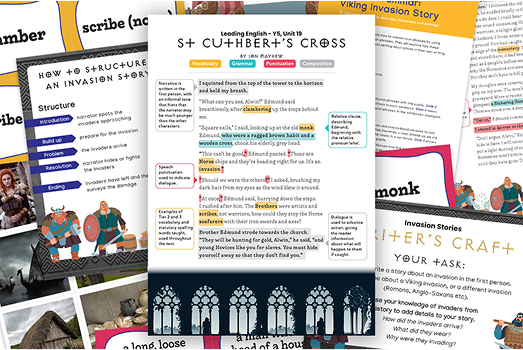There's a lot to digest in the DfE’s July 2025 writing framework.
It draws on a strong body of informed research, aiming to support schools with the statutory writing requirements of the national curriculum and EYFS framework.
Most likely, your school is already doing much of what is suggested in the guidance, and the audit tools it includes will be very helpful to your school’s self-evaluative process.
The writing framework in brief
This article isn’t intended as a writing framework summary (the DfE has already done that). To give a general overview though, the guidance suggests that:
The process of writing is challenging, and so high-quality teaching for all children is essential if we are to transform children from novice to fluent – and motivate writers.
Getting transcription (spelling and handwriting) as automatic as possible, as early as possible, frees children to become confident and successful writers.
Oral composition needs to be prioritised in EYFS and should be continued as part of the teaching process through each of the key stages.
We can help children work towards higher-quality writing by emphasising the reviewing and reworking aspects. This will result in fewer but better-crafted outcomes.
All of the above will require effective school leadership; the audit tools provided will support this.
The creation of a positive writing environment and a commitment to the success of all children are essential.
For many schools, the biggest changes may be around how to focus earlier on transcription skills, while sustaining oral language development as per OFSTED’s Strong Foundations document last year. We have seen the outcomes when these two prongs of writing are developed early: confident, happy writers, expressing themselves freely.
The writing framework ‘s suggested sequence for composition may also require a shift in writing culture/attitude. But we believe this approach takes pressure off writing: it doesn’t have to be perfect straight away – rework it, like clay!
Aims of the writing framework
These are stated explicitly:
Using research to help schools with the EYFS statutory framework and the national curriculum;
Meeting the cross-curricular writing (and reading) demands of Year 7;
This begins in Reception, especially in the development of language.
It is important to note these stated aims, as they clarify the intent of each section.
In school, we should regard the teaching of spelling, handwriting and grammar as skills that serve the fluent expression of thoughts in writing. Ensure children are aware of this, and be cautious of too much decontextualised work.
The national curriculum review
A review of the primary curriculum is ongoing at the time of publication. However, as the writing framework aims to set out a research-based conceptual model for teaching writing, any curricular or assessment changes will not impact it dramatically.
The importance of writing, and a conceptual model
The writing framework references research that shows how writing supports memory, problem-solving and well-being.
We must all remember too, that writing supports reading, as well as vice-versa.
Note the suggestion to distinguish reading for pleasure and drawing on texts to support writing: children shouldn’t think reading is only a pre-writing analysis!
The writing framework uses The Simple View of Reading (which is described in the reading framework) to explain The Simple View of Writing (both of which inform the national curriculum).
Note that both compositional and transcriptional proficiency are necessary to write effectively.
Writing is difficult because its components are difficult:
It is hard enough to compose orally;
If you also need to concentrate on pencil grip, spelling, etc., the challenge may feel too great.
The writing framework refers frequently to structuring the teaching of writing to avoid cognitive overload; holding an idea or a simple sentence in one’s head during the act of composition is itself a challenge!
When considering how to get pupils writing freely and with enjoyment, the section on enhancing motivation on page 21 of the framework is essential reading.
The importance of Reception
The writing framework is explicit about literacy learning in Reception impacting achievement at GCSE level. A dual focus on transcriptional skills and oral composition lays the foundations for becoming a proficient writer.
Use the audit tool on pages 29–30 of the framework to guide your approach to writing in the early years.
We’ve noticed commentators suggesting the writing framework wants children drilled at desks on handwriting all day, but the framework actually says nothing of the kind. Teaching children to sit correctly at desks is not the same as saying they must remain seated all day.
We know a school in which Reception children started to visit a Y1 classroom every day, from January, for ‘handwriting lessons’. This began as one to two minutes of sitting at desks, building up to 15 mins a day by Summer 2. The children loved it, and the impact on outcomes is already strong.
The advice on pages 24–26 is really supportive, and we urge teachers and leaders to read it. For example:
Learn letters as movements; this may require learning directional language (useful in its own right).
High-quality oral interactions support the development of language.
Teach children to compose simple sentences orally.
Develop whole-body strength and fine motor skills by maximising usual Reception practice.
Demonstrate writing and have writing resources available during play.
Transcription
Pupils need to develop the skills required for making what they want to say into symbols on a page.
The more we have to think about transcription, the less working memory is available for our compositions, so children need to build automaticity of these skills.
When addressing transcription do pay attention to children who read well and contribute orally, but dislike or struggle with writing.
Transcription skills – handwriting
Fluent handwriting predicts positive writing outcomes, while struggling to write by hand impacts working memory, causing demotivation.
Do make use of the audit tool on pages 37–39 of the writing framework to guide you. P 34–36 of the framework offers helpful suggestions for supporting the physical demands, including adaptations for left-handed writers.
Ensure all colleagues understand this is not about pretty or perfect handwriting, but fluent legibility. Good handwriting is a means towards free, confident written composition.
Typically, children develop incorrect letter movements because they repeat them. Avoid this by ensuring solid consolidation, rather than rushing on. Teachers’ own handwriting should provide a model of fluent legibility too (it doesn’t have to be immaculate).
Check that handwriting instruction is incremental across all year groups, and make sure everyone is following the same style/scheme. This supports progression and avoids confusing children.
Finally, use the national curriculum handwriting programmes of study for year-specific expectations.
Transcription skills – spelling
Poor spelling pressurises working memory and restricts expression, and children who struggle with spelling write less, less frequently and at a lower quality. All colleagues need to understand this.
Use audit tool on page 45 of the framework to guide your approach to spelling.
The framework is relatively light on spelling, because phonics programmes and the curriculum itself both give so much detail, but it does state that spelling practice should be regular and consistent, like handwriting.
Learn new words as vocabulary before learning to spell them.
Practise previously-taught words to develop automaticity (dictation is helpful here).
Learn exception words (e.g. by identifying the tricky part, or a mnemonic).
Practise spellings in handwriting tasks.
Use resources such as morpheme matrices to explore morphology. Appendix B gives excellent examples of morpheme matrices. We like to use these in a physical, card-game based way.
The writing framework does include a couple of really important points on the teaching of spelling that we think are worth drawing attention to:
Avoid pressure on spelling when children are composing.
Build in time for children to return to their compositions to edit spelling (and grammar and punctuation).
The framework points out that typing is a useful skill to develop, but time-consuming to learn. Handwriting is better for the development of spelling, enhances memorising information and even improves reading speed and accuracy.
Transcription skills – dictation
Many schools under-use dictation, especially post-phonics; we find it a powerful way of practising transcription and punctuation, and even reinforcing new sentence structures. The writing framework points out that dictation is an effective way of practising both of the transcription skills while scaffolding composition.
Composition
As already noted, the writing framework is strong on composition beginning orally, and we recommend looking at this in school. Use the audit tool on pages 72–73 to guide you.
The writing framework provides helpful advice on the teaching of sentence structure. Some of this is likely to feel quite familiar (some of us will remember Grammar for Writing, from 20+ years ago!).
We very strongly recommend you explore the resources in Appendix D of the writing framework: examples of research-backed sentence-development activities. Use sentence-combining, if you aren’t already, and consider physical manipulation of sentences on paper or card, as well as purely oral work.
The vocabulary advice has been in our schools for fewer years, though it may still be familiar to you. It refers back to Beck, McKeown and Kucan’s research – influential in many schools currently prioritising oral and written communication.
The key takeaways here are the emphasis on developing grammar and vocabulary skills to enhance children’s abilities to express themselves – not as ends in themselves.
The writing process
The writing framework presents an adaptation of a sequence published by the EEF:
planning
drafting
revising (making changes for impact and content)
editing (correcting errors of spelling, grammar and punctuation)
sharing
Look at what is already happening in school, and move in small steps towards this authentic process. It’s not linear: for example, sharing can happen throughout and is helpful to the revising (and editing) process.
Note that the writing framework uses sharing rather than publishing because not every piece needs to be published, but writing should be shared, so children learn to grasp the importance of the non-present reader.
Appendix F (p116) provides helpful understanding of what this process looks like in different years. The process is dependent on effective, actionable feedback, and the writing framework provides research-backed guidance on pages 70–71.
The advice on paragraph-building (p68–69) is some of the best we’ve encountered, as is the progression through cohesion and coherence, explained in detail on page 70, with highly-developed examples in Appendix I.
The effectiveness of modelled and shared writing is research-backed: check practice often, and refresh with regular training.
Resources for pupils who need the additional support
The writing framework emphasises high expectations and ambition for all children, including pupils identified as having SEND difficulties. Use the audit tools ‘Keeping up from the start’ (p79) and ‘Pupils who need further support’ (p85) to help you plan and monitor coverage for these children.
The framework correctly identifies the importance of spotting children falling behind in writing as early as possible. We often find children are noted as ‘slow progress’ or ‘reluctant’ writers, without clarity around why.
Use the components of writing identified throughout the framework to help. Children can fall behind for all sorts of reasons, including poor pencil grip, awkward letter formation, inconsistent sentence structure, and so on.
As children get older, gaps get wider – and self-esteem issues arise. However, addressing the weakest components of a child’s work while praising the strongest is a powerful approach.
The writing framework offers a summary of research-backed advice for children identified with specific SEND needs, including developmental language disorder, dyslexia, dyspraxia and pupils with more complex needs. It makes the crucial point that literacy is no less important for these pupils, and that specific difficulties may increase strain on working memory.
Therefore, taking an adaptive, scaffolded approach led by children’s specific needs and working with the SENDCo is strongly advised.
Writing across the curriculum
The key messages here are around opportunities for practising the skills taught, and consistency in terminology, models and expectations from English into all lessons.
Reinforce the point that writing is a means for thinking, remembering and communication. There is solid advice for transition into KS3 in this section.
Leadership and management
Use audit tool on pages 95 – 96 to inform your leadership and management decisions. The key takeaways on leadership in the writing framework are that:
Headteachers should take responsibility for building a motivating and positive writing culture. This means a well-sequenced curriculum and high expectations for all.
Writing leads must be confident about the physical as well as cognitive development of writing, including in Reception.
If writing and reading are separately led, these colleagues must work very closely.
Every teacher must be involved in professional development for writing.
The SENDCo is key in the leadership of writing for all children.
Assessment
The writing framework is succinct on national assessment as schools already have access to this information. It makes the point that aspects of each of the national assessments can contribute to teachers’ understanding of individual children’s areas for development.
We recommend reading the sections on objective and subjective measures, as well as AI assessment (pp93–94) as this is likely to be under consideration now.
The writing framework also makes the point that it isn’t always possible to judge writing ability by looking in books. We regularly encounter children who appear to be poor composers on the page, but are actually just poor transcribers. Fluent handwriting can set them free.
We recommend using the components of writing as outlined throughout the framework to support formative assessment of writing.
In conclusion...
The writing framework seeks writing competence for all children by addressing the components that hold too many children back.
It reminds us that that the writing process poses real challenges to working memory and there is much we can put in place to relieve this so that children experience success.
The section dealing with motivation is key. There are multiple ways of helping children to want to write, from making it physically easier, to ensuring they know the subject matter well enough, from peer-collaboration to occasional publication – and so much more.
Christine Chen and Lindsay Pickton are primary education advisors (primaryeducationadvisors.co.uk), supporting English development nationally.





